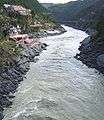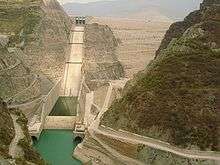Bhagirathi River
The Bhāgīrathī (Pron:/ˌbʌgɪˈɹɑːθɪ/) is a turbulent Himalayan river in the Indian state of Uttarakhand, and one of the two headstreams (or source) of the Ganges, the major river of Northern India and considered holy in Hinduism. In Hindu faith and culture, the Bhagirathi is considered the source stream of the Ganges. However, in hydrology, the other headstream, Alaknanda, is considered the source stream on account of its great length and discharge.
| Bhāgīrathī River | |
|---|---|
Sacred bathing ghats on Bhagirathi River at Gangotri | |
Map showing the Himalayan headwaters of the Bhagirathi river. The numbers in parentheses refer to the altitude in meters. | |
| Etymology | "Bhagirathi" (Sanskrit, literally, "caused by Bhagiratha") |
| Native name | भागीरथी |
| Location | |
| Country | India |
| State | Uttarakhand, |
| Region | Garhwal division |
| District | Uttar Kashi District, Tehri District |
| Physical characteristics | |
| Source | Gaumukh (gou, cow + mukh, face), about 18 km (11.2 mi) from the town of Gangotri |
| • coordinates | 30.925449°N 79.081480°E |
| • elevation | 3,892 m (12,769 ft) |
| Source confluence | Alaknanda River |
| Mouth | Ganges |
• location | Devprayag, Uttarakhand, India |
• coordinates | 30.146315°N 78.598251°E |
• elevation | 475 m (1,558 ft) |
| Length | 205 km (127 mi) |
| Basin size | 6,921 km2 (2,672 sq mi) |
| Discharge | |
| • average | 257.78 m3/s (9,103 cu ft/s) |
| • maximum | 3,800 m3/s (130,000 cu ft/s) |
| [1] | |
The Ganga is the most important river of India both from the point of view of its basin and cultural significance. It rises in the Gangotri glacier near Gaumukh (3,900 m) in the Uttarkashi district of Uttarakhand. Here, it is known as the Bhagirathi.
Etymology
The word "Bhagirathi" (Sanskrit, literally, "caused by Bhagiratha") refers to a mythological Sagar Dynasty prince who, to gain the release of his 10,000 great-uncles from the curse of saint Kapila, brought the goddess Ganga in the form of the river Ganges, from the heavens to the earth. Hence, Ganges considered as the daughter of Bhagiratha and Ganges also called Baghirathi.[2] Bhagiratha was the king of Kosala, a kingdom in ancient India. He was a descendant of the great King Sagara of the Suryavanshi, or Surya Dynasty. He was one of the forefathers of Lord Rama, of the Ramayana, the epic in which Bhagiratha's tale is primarily recounted. The story of Bhagiratha explained in Balakhanda of Ramayana.Shiva brought Ganga river to Bindu Sarovar on request of Bhagiratha.[3][4][5]
Course
The headwaters of the Bhagirathi are formed at Gaumukh (elevation 3,892 metres (12,769 ft)), at the foot of the Gangotri glacier and Khatling glaciers in the Garhwal Himalaya. It is then joined by its tributaries; these are, in order from the source:
- Kedar Ganga at Gangotri (elevation 3,049 m (10,003 ft)),
- Jadh Ganga at Bhaironghati (elevation 2,650 m (8,690 ft)),
- Kakora Gad and Jalandhari Gad near Harsil (elevation 2,745 m (9,006 ft)),
- Siyan Gad near Jhala (elevation 2,575 m (8,448 ft)),
- Asi Ganga near Uttarkashi (elevation 1,158 m (3,799 ft)),
- Bhilangna River near Old Tehri (elevation 755 m (2,477 ft)).
The Bhilangna itself rises at the foot of the Khatling Glacier (elevation 3,717 m (12,195 ft)) approximately 50 km (31 mi) south of Gaumukh.
The river flows from its source for 205 km (127 mi) before meeting the Alaknanda River at an elevation of 475 m (1,558 ft) in the town of Devprayag. Downstream of this confluence, considered holy by Hindus, the river is known as the Ganga, or Ganges River by westerners. The controversial Tehri dam lies at the confluence of the Bhāgirathi and the Bhilangna, at 30°22′32″N 78°28′48″E, near Tehri. Chaukhamba I is the highest point of the Bhagirathi basin.
Dams
There are 18 dams along the Bhāgirathi River, either in operation, under construction or planned. These are, in order from the source:
| # | Name | Ht | MW | Status | FRL | MWL | HRT | TRT | TWL | RBL | Coordinates |
|---|---|---|---|---|---|---|---|---|---|---|---|
| 1 | Karmoli Dam | 140 | planned | 8.6 | |||||||
| 2 | Gangotri Dam | 55 | planned | 5.2 | |||||||
| 3 | Jadhganga Dam | 50 | planned | 1.1 | |||||||
| 4 | Bhaironghati I Dam | 380 | planned | ||||||||
| 5 | Bhaironghati II Dam | 65 | planned | ||||||||
| 6 | Harsil Dam | 210 | planned | 5.06 | |||||||
| 7 | Loharinag Pala Dam | 600 | cancelled | 2,147 | 1,667 | 13.85 | .51 | 1.665 | 30°58′6″N 78°41′56″E | ||
| 8 | Pala Maneri I Dam | 78 | 480 | cancelled | 1,665 | 1,667 | 12.563 | 1.378 | |||
| 9 | Maneri Dam | 38 | 90 | operation | 8.631 | ||||||
| 10 | Joshiyara (Bhali) Dam | 304 | operation | 16.0 | |||||||
| 11 | Bhilangana II Dam | 11 | planned | ||||||||
| 12 | Bhilangana I Dam | 22.5 | planned | 2.0 | |||||||
| 13 | Tehri Dam | 260.5 | 2,400 | operation | 830 | 835 | 1.634 | .8625 | 30°22′40″N 78°28′50″E | ||
| 14 | Koteshwar Dam | 97.5 | 400 | operation | 612.50 | 615 | |||||
| 15 | Kotli Bel 1A Dam | 82.5 | 195 | construction | |||||||
| 16 | Kotli Bel 1B Dam | 90 | 320 | cancelled | |||||||
| 17 | Kotli Bel II Dam | 82 | 530 | cancelled | |||||||
Notes
- Catchment Area Treatment:, Bhagirathi River Valley Development Authority, Uttaranchal
- Mankodi, Kirit (1973) "Gaṅgā Tripathagā"Artibus Asiae 35(1/2): pp. 139-144, p. 140
- Gopal, Madan (1990). K.S. Gautam (ed.). India through the ages. Publication Division, Ministry of Information and Broadcasting, Government of India. p. 76.
- "Gangaa/Ganga of Purana Index".
- "The Story of Ganga : River Goddess".
- "Map of the Bhagirathi River showing dams" (PDF). Dams, Rivers & People. South Asian Network on Dams Rivers & People(sandrp.in). August 2008. Archived from the original (PDF) on 23 May 2011. Retrieved 7 March 2010.
References
- Wilson, W. (1860). A summer ramble in the Himalayas: with sporting adventures in the Vale of Cashmere. London: Hurst and Blackett. OCLC 58410561. available on microfilm
- Heske, Franz (1937). Im heiligen Lande der Gangesquellen (In the Holy Lands of the Source of the Ganges) (in German). Neudamm, Germany: J. Neumann. OCLC 35036471.
- Sharma, Man Mohan (1997). Through the Valley of Gods: Travels in the Central Himalayas (2 ed.). New Delhi: Vision Books. OCLC 4547622.
External links
| Wikimedia Commons has media related to Bhagirathi River. |


